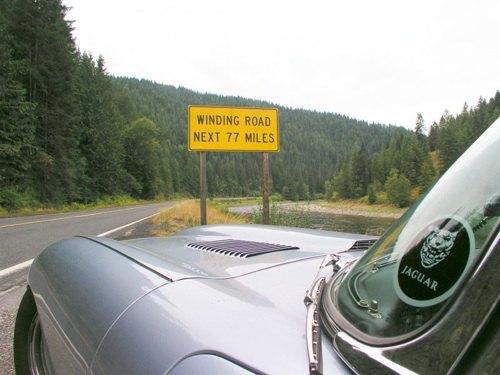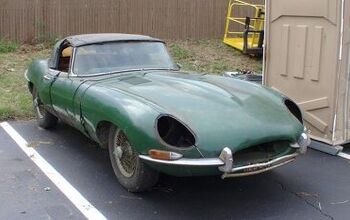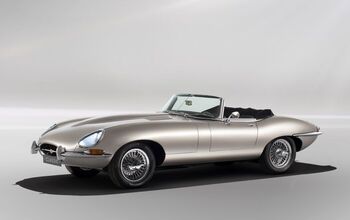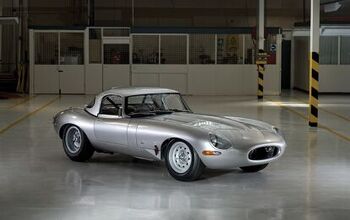Review: 1965 Jaguar E-Type

The sun breaks through trees and plays off the long bonnet. As I loaf along the arrow-straight road, I absorb the soundtrack: the baritone exhaust note of the big-bore, long-stroke, inline-six. Ahead, I spot that sign that makes every true driver shut down the internal dialog in their brain and focus on the here and now: Winding Road. Amazing what a sign can do to lift one’s spirit. In a Jaguar E-Type, elevation quickly becomes ecstasy.
The road dives down and to the left, as I blip the throttle and snap the solid shifter down from fourth into third. As the revs rise and fall the big pipe organ that droned a single note is joined by a mechanical symphony. There’s a distinctive whine from the intake, produced by three trumpeted two-inch Skinner’s Union HD8 carburetors. The entire cylinder head adds a delicious rustle: chain-driven dual overhead cams spinning furiously at the insistence of my right foot. Underlying it all: the booming low notes of the exhaust, throbbing as if The Ox himself was laying down the bass track.
The car handles corners with aplomb; I could take each one at twice the speed without so much as a squeak of complaint from the tires. But the realization that I’m driving a forty-four year old car holds me back. This car was built in a time when going fast and looking good were the priorities, not saving the planet or protecting the occupant. The E-Type’s seat rises as high as my shoulder blades. In a bad shunt, the seat belts would only serve to secure my body while the windscreen decapitated me, in the blink of an eye. No air bags or handling nanny here; the only safety systems on board are my grey matter and the skill of my hands and feet. Stirling Moss will have to wait. Fortunately, even at velocities well within the posted limits, the E-Type provides endless satisfaction. The driving experience is worth risks Ralph Nader could never even imagine.
The E-type Jaguar arrived on the automotive scene in 1961, like a cruise missile vectoring into a stone-age village. It brought with it technologies extracted from the rarified world of endurance racing, bringing world-beating performance to the street for a shockingly reasonable price.
The E-Type outperformed the contemporary Ferrari 410 SuperAmerica ($16,800) or a 250 GT Berlinetta SWB ($11,800), for less than half the price. When new, the Jaguar sold for $5,595. Il Commendatore himself labelled the E-type “The most beautiful car ever made” . . . while swiftly copying it in the form of the 250 GTO, and again with the 275&365 GTB/4s. The E-Type also prompted redesigns of other sports cars, notably here in America, Chevrolet’s Corvette; look at the radical difference between the C1 & C2.
The E-type is a race car adapted for the street, not a purpose-built race car like it’s predecessors, the C-/D-type Jaguars. The E-type appeared in a few races, with two of the first stock units topping the podium in their initial outing at Oulton Park (in their native England). But, in the end, E-Types were not that successful at the big races of the era: Le Mans, Sebring, the Nürburgring. The E-Type always finished near but never at the top of the podium.
Still, the E-Type offered truly innovative-for-the-day technology, some of which has become standard equipment across the automotive spectrum: power-assisted disc brakes, fully-independent rear suspension, unibody construction, rack and pinion steering. In the early ’60s, the E-Type was leading-edge exotica, delivered in the form of reasonably-priced automotive erotica.
Despite its long, low look, the E-Type is deceptively small, especially compared to most other cars on the road. It handles very smoothly thanks to even weight distribution fore and aft; the engine and gearbox sit back well behind the front axle so that weight, with a driver and fuel, is split 50/50. Steering is precise. Oversteer is delivered so smoothly and predictably that in a tight autocross course some steering load can be handled by the loud pedal. Diesel-like torque is available at any RPM, making 50-70+ acceleration and passing on two-lane roads something to seek out and savor.
My E-Type’s original owner purchased the car in Albuquerque, NM. About 15 years ago, my father restored it as his “retirement project” and I bought it from him in 2003 to save his marriage. (True story.) After investing countless hours behind the wheel (and under the bonnet), I can report that the Jaguar E-Type’s not the fastest classic car money can buy. Nor is it the best around a skidpad. But none of that really matters with an E-type Jaguar. The car provides masses of dynamic feedback and makes great noises. Phallic issues aside, it’s drop-dead gorgeous. When you’re heading down a twisting two lane road, when there’s nothing but zen ahead, what else do you need?

Second Generation Car Guy living in the Sasquatch-filled wooded hills of the Pacific Northwest with an old E-type Jaguar and a lawnmower that run on gasoline. Everything else I drive runs on home-brew BioDiesel.
More by Chuck Goolsbee
Latest Car Reviews
Read moreLatest Product Reviews
Read moreRecent Comments
- Joe65688619 Under Ghosn they went through the same short-term bottom-line thinking that GM did in the 80s/90s, and they have not recovered say, to their heyday in the 50s and 60s in terms of market share and innovation. Poor design decisions (a CVT in their front-wheel drive "4-Door Sports Car", model overlap in a poorly performing segment (they never needed the Altima AND the Maxima...what they needed was one vehicle with different drivetrain, including hybrid, to compete with the Accord/Camry, and decontenting their vehicles: My 2012 QX56 (I know, not a Nissan, but the same holds for the Armada) had power rear windows in the cargo area that could vent, a glass hatch on the back door that could be opened separate from the whole liftgate (in such a tall vehicle, kinda essential if you have it in a garage and want to load the trunk without having to open the garage door to make room for the lift gate), a nice driver's side folding armrest, and a few other quality-of-life details absent from my 2018 QX80. In a competitive market this attention to detai is can be the differentiator that sell cars. Now they are caught in the middle of the market, competing more with Hyundai and Kia and selling discounted vehicles near the same price points, but losing money on them. They invested also invested a lot in niche platforms. The Leaf was one of the first full EVs, but never really evolved. They misjudged the market - luxury EVs are selling, small budget models not so much. Variable compression engines offering little in terms of real-world power or tech, let a lot of complexity that is leading to higher failure rates. Aside from the Z and GT-R (low volume models), not much forced induction (whether your a fan or not, look at what Honda did with the CR-V and Acura RDX - same chassis, slap a turbo on it, make it nicer inside, and now you can sell it as a semi-premium brand with higher markup). That said, I do believe they retain the technical and engineering capability to do far better. About time management realized they need to make smarter investments and understand their markets better.
- Kwik_Shift_Pro4X Off-road fluff on vehicles that should not be off road needs to die.
- Kwik_Shift_Pro4X Saw this posted on social media; “Just bought a 2023 Tundra with the 14" screen. Let my son borrow it for the afternoon, he connected his phone to listen to his iTunes.The next day my insurance company raised my rates and added my son to my policy. The email said that a private company showed that my son drove the vehicle. He already had his own vehicle that he was insuring.My insurance company demanded he give all his insurance info and some private info for proof. He declined for privacy reasons and my insurance cancelled my policy.These new vehicles with their tech are on condition that we give up our privacy to enter their world. It's not worth it people.”
- TheEndlessEnigma Poor planning here, dropping a Vinfast dealer in Pensacola FL is just not going to work. I love Pensacola and that part of the Gulf Coast, but that area is by no means an EV adoption demographic.
- Keith Most of the stanced VAGS with roof racks are nuisance drivers in my area. Very likely this one's been driven hard. And that silly roof rack is extra $'s, likely at full retail lol. Reminds me of the guys back in the late 20th century would put in their ads that the installed aftermarket stereo would be a negotiated extra. Were they going to go find and reinstall that old Delco if you didn't want the Kraco/Jenson set up they hacked in?






































Comments
Join the conversation
Sled, I have two knock-offs from my dad's 1970 E-Type as paper weights on my desk. Unfortunately it is all that I have of her as dad sold her for an Alfa 2000 GTV. Frankly, a real Italian mistress would have been more dependable and less expensive. Neither, though, would have had the enduring beauty of an E-Type.
I bought a 68 ots about 5 years back and the previous owner had put a motolita steering wheel on it and that was the first thing i replaced with the restores original wheel.